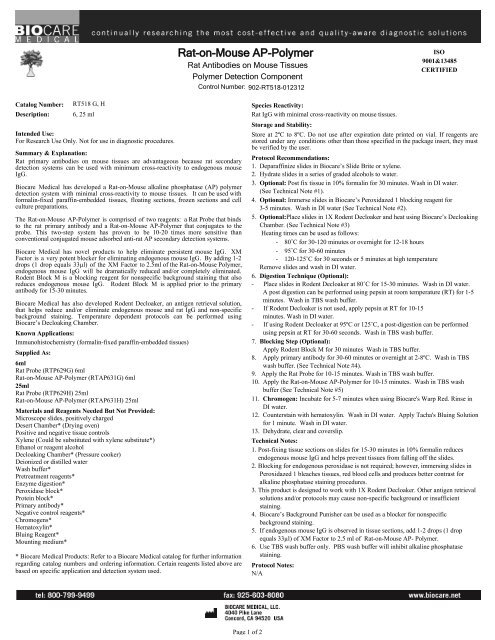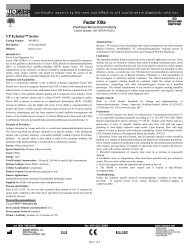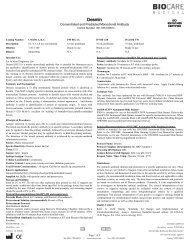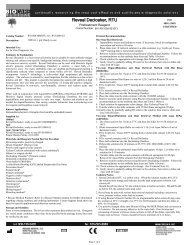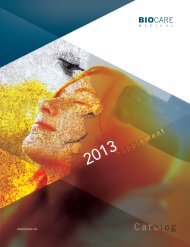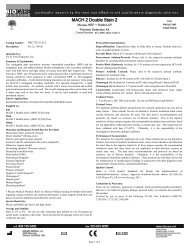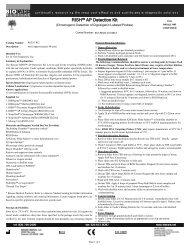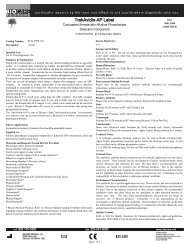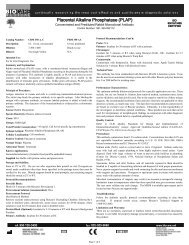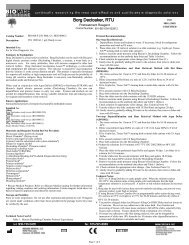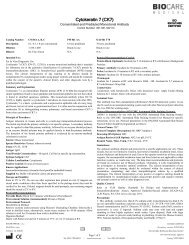Data Sheet - Biocare Medical
Data Sheet - Biocare Medical
Data Sheet - Biocare Medical
Create successful ePaper yourself
Turn your PDF publications into a flip-book with our unique Google optimized e-Paper software.
Rat-on-Mouse AP-Polymer<br />
Rat Antibodies on Mouse Tissues<br />
Polymer Detection Component<br />
Control Number: 902-RT518-012312<br />
ISO<br />
9001&13485<br />
CERTIFIED<br />
Catalog Number:<br />
Description:<br />
RT518 G, H<br />
6, 25 ml<br />
Intended Use:<br />
For Research Use Only. Not for use in diagnostic procedures.<br />
Summary & Explanation:<br />
Rat primary antibodies on mouse tissues are advantageous because rat secondary<br />
detection systems can be used with minimum cross-reactivity to endogenous mouse<br />
IgG.<br />
<strong>Biocare</strong> <strong>Medical</strong> has developed a Rat-on-Mouse alkaline phosphatase (AP) polymer<br />
detection system with minimal cross-reactivity to mouse tissues. It can be used with<br />
formalin-fixed paraffin-embedded tissues, floating sections, frozen sections and cell<br />
culture preparations.<br />
The Rat-on-Mouse AP-Polymer is comprised of two reagents: a Rat Probe that binds<br />
to the rat primary antibody and a Rat-on-Mouse AP-Polymer that conjugates to the<br />
probe. This two-step system has proven to be 10-20 times more sensitive than<br />
conventional conjugated mouse adsorbed anti-rat AP secondary detection systems.<br />
<strong>Biocare</strong> <strong>Medical</strong> has novel products to help eliminate persistent mouse IgG. XM<br />
Factor is a very potent blocker for eliminating endogenous mouse IgG. By adding 1-2<br />
drops (1 drop equals 33µl) of the XM Factor to 2.5ml of the Rat-on-Mouse Polymer,<br />
endogenous mouse IgG will be dramatically reduced and/or completely eliminated.<br />
Rodent Block M is a blocking reagent for nonspecific background staining that also<br />
reduces endogenous mouse IgG. Rodent Block M is applied prior to the primary<br />
antibody for 15-30 minutes.<br />
<strong>Biocare</strong> <strong>Medical</strong> has also developed Rodent Decloaker, an antigen retrieval solution,<br />
that helps reduce and/or eliminate endogenous mouse and rat IgG and non-specific<br />
background staining. Temperature dependent protocols can be performed using<br />
<strong>Biocare</strong>’s Decloaking Chamber.<br />
Known Applications:<br />
Immunohistochemistry (formalin-fixed paraffin-embedded tissues)<br />
Supplied As:<br />
6ml<br />
Rat Probe (RTP629G) 6ml<br />
Rat-on-Mouse AP-Polymer (RTAP631G) 6ml<br />
25ml<br />
Rat Probe (RTP629H) 25ml<br />
Rat-on-Mouse AP-Polymer (RTAP631H) 25ml<br />
Materials and Reagents Needed But Not Provided:<br />
Microscope slides, positively charged<br />
Desert Chamber* (Drying oven)<br />
Positive and negative tissue controls<br />
Xylene (Could be substituted with xylene substitute*)<br />
Ethanol or reagent alcohol<br />
Decloaking Chamber* (Pressure cooker)<br />
Deionized or distilled water<br />
Wash buffer*<br />
Pretreatment reagents*<br />
Enzyme digestion*<br />
Peroxidase block*<br />
Protein block*<br />
Primary antibody*<br />
Negative control reagents*<br />
Chromogens*<br />
Hematoxylin*<br />
Bluing Reagent*<br />
Mounting medium*<br />
* <strong>Biocare</strong> <strong>Medical</strong> Products: Refer to a <strong>Biocare</strong> <strong>Medical</strong> catalog for further information<br />
regarding catalog numbers and ordering information. Certain reagents listed above are<br />
based on specific application and detection system used.<br />
Species Reactivity:<br />
Rat IgG with minimal cross-reactivity on mouse tissues.<br />
Storage and Stability:<br />
Store at 2ºC to 8ºC. Do not use after expiration date printed on vial. If reagents are<br />
stored under any conditions other than those specified in the package insert, they must<br />
be verified by the user.<br />
Protocol Recommendations:<br />
1. Deparaffinize slides in <strong>Biocare</strong>’s Slide Brite or xylene.<br />
2. Hydrate slides in a series of graded alcohols to water.<br />
3. Optional: Post fix tissue in 10% formalin for 30 minutes. Wash in DI water.<br />
(See Technical Note #1).<br />
4. Optional: Immerse slides in <strong>Biocare</strong>’s Peroxidazed 1 blocking reagent for<br />
3-5 minutes. Wash in DI water (See Technical Note #2).<br />
5. Optional:Place slides in 1X Rodent Decloaker and heat using <strong>Biocare</strong>’s Decloaking<br />
Chamber. (See Technical Note #3)<br />
Heating times can be used as follows:<br />
- 80˚C for 30-120 minutes or overnight for 12-18 hours<br />
- 95˚C for 30-60 minutes<br />
- 120-125˚C for 30 seconds or 5 minutes at high temperature<br />
Remove slides and wash in DI water.<br />
6. Digestion Technique (Optional):<br />
- Place slides in Rodent Decloaker at 80˚C for 15-30 minutes. Wash in DI water.<br />
A post digestion can be performed using pepsin at room temperature (RT) for 1-5<br />
minutes. Wash in TBS wash buffer.<br />
- If Rodent Decloaker is not used, apply pepsin at RT for 10-15<br />
minutes. Wash in DI water.<br />
- If using Rodent Decloaker at 95ºC or 125˚C, a post-digestion can be performed<br />
using pepsin at RT for 30-60 seconds. Wash in TBS wash buffer.<br />
7. Blocking Step (Optional):<br />
Apply Rodent Block M for 30 minutes Wash in TBS buffer.<br />
8. Apply primary antibody for 30-60 minutes or overnight at 2-8ºC. Wash in TBS<br />
wash buffer. (See Technical Note #4).<br />
9. Apply the Rat Probe for 10-15 minutes. Wash in TBS wash buffer.<br />
10. Apply the Rat-on-Mouse AP-Polymer for 10-15 minutes. Wash in TBS wash<br />
buffer (See Technical Note #5)<br />
11. Chromogen: Incubate for 5-7 minutes when using <strong>Biocare</strong>'s Warp Red. Rinse in<br />
DI water.<br />
12. Counterstain with hematoxylin. Wash in DI water. Apply Tacha's Bluing Solution<br />
for 1 minute. Wash in DI water.<br />
13. Dehydrate, clear and coverslip.<br />
Technical Notes:<br />
1. Post-fixing tissue sections on slides for 15-30 minutes in 10% formalin reduces<br />
endogenous mouse IgG and helps prevent tissues from falling off the slides.<br />
2. Blocking for endogenous peroxidase is not required; however, immersing slides in<br />
Peroxidazed 1 bleaches tissues, red blood cells and produces better contrast for<br />
alkaline phosphatase staining procedures.<br />
3. This product is designed to work with 1X Rodent Decloaker. Other antigen retrieval<br />
solutions and/or protocols may cause non-specific background or insufficient<br />
staining.<br />
4. <strong>Biocare</strong>’s Background Punisher can be used as a blocker for nonspecific<br />
background staining.<br />
5. If endogenous mouse IgG is observed in tissue sections, add 1-2 drops (1 drop<br />
equals 33µl) of XM Factor to 2.5 ml of Rat-on-Mouse AP- Polymer.<br />
6. Use TBS wash buffer only. PBS wash buffer will inhibit alkaline phosphatase<br />
staining.<br />
Protocol Notes:<br />
N/A<br />
Page 1 of 2
Rat-on-Mouse AP-Polymer<br />
Rat Antibodies on Mouse Tissues<br />
Polymer Detection Component<br />
Control Number: 902-RT518-012312<br />
ISO<br />
9001&13485<br />
CERTIFIED<br />
Precautions:<br />
This product is not classified as hazardous. The preservative used in this reagent is<br />
Proclin 300 and the concentration is less than 0.25%. Overexposure to Proclin 300 can<br />
cause skin and eye irritation and irritation to mucous membranes and upper respiratory<br />
tract. The concentration of Proclin 300 in this product does not meet the OSHA<br />
criteria for a hazardous substance. Wear disposable gloves when handling reagents.<br />
Specimens, before and after fixation, and all materials exposed to them should be<br />
handled as if capable of transmitting infection and disposed of with proper precautions.<br />
Never pipette reagents by mouth and avoid contacting the skin and mucous membranes<br />
with reagents and specimens. If reagents or specimens come in contact with sensitive<br />
areas, wash with copious amounts of water. Microbial contamination of reagents may<br />
result in an increase in nonspecific staining. Incubation times or temperatures other<br />
than those specified may give erroneous results. The user must validate any such<br />
change. The MSDS is available upon request and is located at http://biocare.<br />
net/support/msds/.<br />
Consult OSHA, federal, state or local regulations for disposal of any toxic substances.<br />
Proclin TM is a trademark of Rohm and Haas Company, or of its subsidiaries or<br />
affiliates.<br />
Troubleshooting:<br />
Follow the reagent specific protocol recommendations according to data sheet<br />
provided. If atypical results occur, contact <strong>Biocare</strong>'s Technical Support at 1-800-542<br />
-2002.<br />
Troubleshooting Guide:<br />
No Staining<br />
1. Critical reagent (such as primary antibody) omitted.<br />
2. Staining steps performed incorrectly or in the wrong order.<br />
3. Heat-induced epitope retrieval (HIER) step was performed incorrectly using the<br />
wrong time, the wrong order or the wrong pretreatment.<br />
4. Insufficient amount of antigen.<br />
5. Primary antibody incubation period too short.<br />
6. Improperly mixed substrate and/or chromogen solution(s).<br />
Weak Staining<br />
1. Tissue is either over-fixed or under-fixed.<br />
2. Primary antibody incubation too short.<br />
3. Low expression of antigen.<br />
4. Heat-induced epitope retrieval (HIER) steps performed incorrectly using wrong<br />
time, in the wrong order, or the wrong pretreatment.<br />
5. Over-development of substrate.<br />
6. Excessive rinsing during wash steps.<br />
7. Omission of critical reagent.<br />
8. Incorrect procedure in reagent preparation.<br />
9. Improper procedure in test steps.<br />
Non-specific or High Background Staining<br />
1. Tissue is either over-fixed or under-fixed.<br />
2. Endogenous alkaline phosphatase (not blocked with levamisole).<br />
3. Incorrect blocking reagent used; blocker should be from same species in which the<br />
secondary antibody was raised.<br />
4. Tissue may need a longer or a more specific protein block.<br />
5. Substrate is overly-developed.<br />
6. Tissue was inadequately rinsed.<br />
7. Deparaffinization incomplete.<br />
8. Tissue damaged or necrotic.<br />
Tissues Falling Off<br />
1. Slides were not positively charged.<br />
2. A slide adhesive was used in the waterbath.<br />
3. Tissue was not dried properly.<br />
4. Tissue contained too much fat.<br />
Specific Staining Too Dark<br />
1. Concentrated antibody not diluted out properly (being used at too high of a<br />
concentration).<br />
2. Incubation of primary antibody, or detection too long.<br />
Performance Characteristics:<br />
The protocols for a specific application can vary. These include, but are not limited to:<br />
fixation, heat-retrieval method, incubation times, tissue section thickness and detection<br />
kit used. Due to the superior sensitivity of these unique reagents, the recommended<br />
incubation times and titers listed are not applicable to other detection systems, as<br />
results may vary. The data sheet recommendations and protocols are based on<br />
exclusive use of <strong>Biocare</strong> products. Ultimately, it is the responsibility of the<br />
investigator to determine optimal conditions. These products are tools that can be used<br />
for interpretation of morphological findings in conjunction with other diagnostic tests<br />
and pertinent clinical data by a qualified pathologist.<br />
Quality Control:<br />
Refer to CLSI Quality Standards for Design and Implementation of<br />
Immunohistochemistry Assays; Approved Guideline-Second edition (I/LA28-A2).<br />
CLSI Wayne, PA, USA (www.clsi.org). 2011<br />
Limitations & Warranty:<br />
There are no warranties, expressed or implied, which extend beyond this description.<br />
<strong>Biocare</strong> is not liable for property damage, personal injury, or economic loss caused by<br />
this product.<br />
Covered by one or more of the following US Pat. Nos. 6,686,461; 6,800,728;<br />
7,102,024; 7,173,125; 7,462,689.<br />
Page 2 of 2


